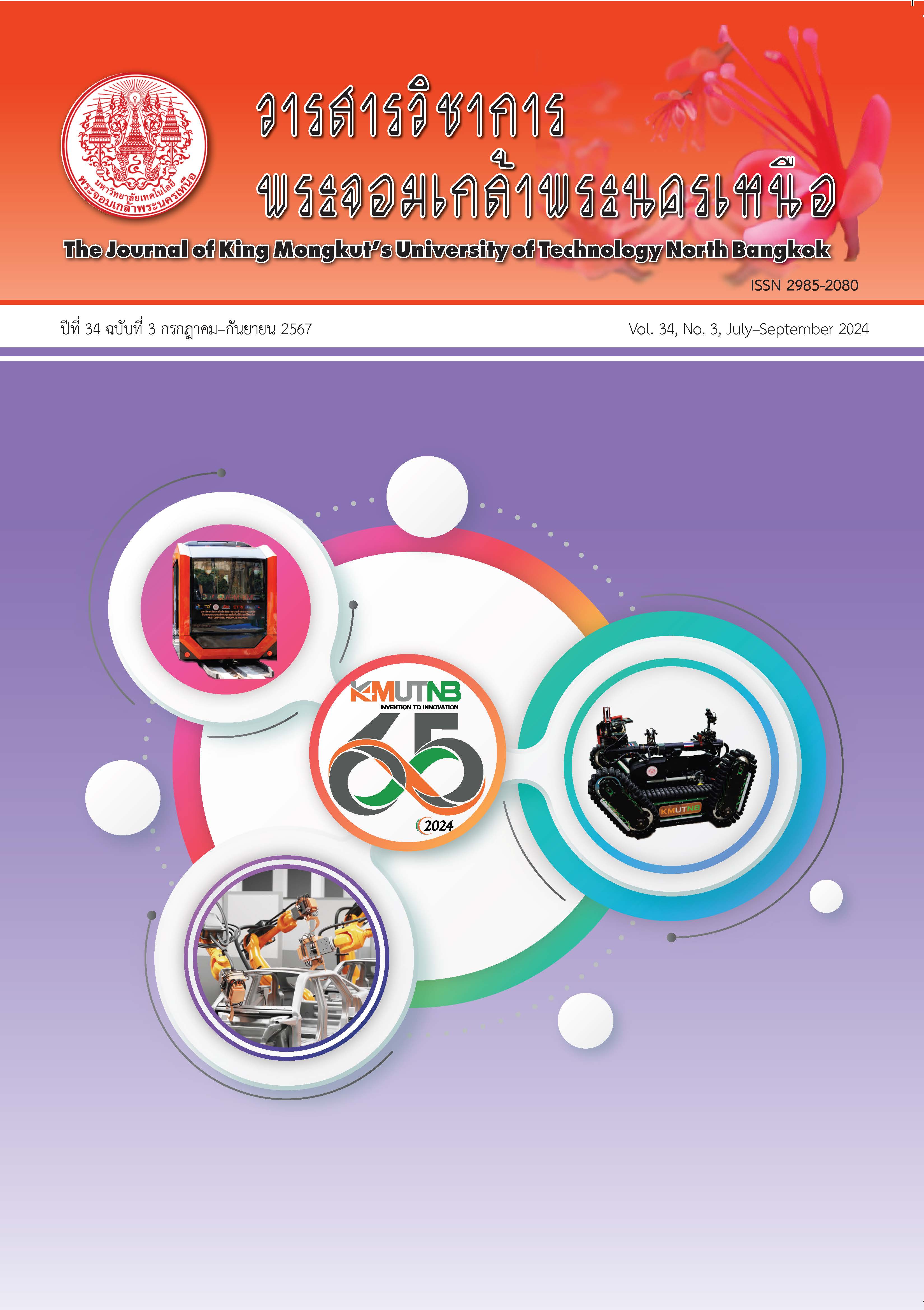การปรับปรุงคุณสมบัติด้านความร้อนของคอนกรีตมวลเบาผสมเม็ดยางด้วยวัสดุเปลี่ยนสถานะ
Main Article Content
บทคัดย่อ
บทความนี้เป็นการปรับปรุงคุณสมบัติด้านความร้อนของคอนกรีตมวลเบาผสมเม็ดยางด้วยวัสดุเปลี่ยนสถานะ งานวิจัยประกอบด้วย 2 ส่วน คือ การปรับปรุงคุณภาพพื้นผิวมวลรวมที่ฝังตัวด้วยวัสดุเปลี่ยนสถานะด้วยซิลิกาฟูมเพื่อศึกษาการสูญเสียวัสดุเปลี่ยนสถานะหลังได้รับความร้อนซ้ำ และศึกษาคุณสมบัติของคอนกรีตผสมเม็ดยางผสมมวลรวมเบาฝังตัวด้วยวัสดุเปลี่ยนสถานะที่ไม่ปรับปรุงพื้นผิว และปรับปรุงพื้นผิวด้วยซิลิกาฟูม กำหนดอัตราส่วนน้ำต่อปูนซีเมนต์ เท่ากับ 0.35 และแทนที่มวลรวมละเอียด (ทราย) ด้วยเม็ดยาง 10 ถึง 30 เปอร์เซ็นต์โดยปริมาตร โดยทำการทดสอบซึ่งประกอบด้วย ในส่วนของมวลรวมเบา ได้แก่ คุณสมบัติของมวลรวมเบาก่อนและหลังปรับปรุงพื้นผิว คุณสมบัติของมวลรวมเบาหลังได้รับความร้อนซ้ำและ ในส่วนของคอนกรีต ได้แก่ คุณสมบัติเชิงกล เชิงกายภาพ และค่าสัมประสิทธิ์การนำความร้อน ผลการทดสอบพบว่า การปรับปรุงพื้นผิวมวลรวมเบาส่งผลให้เปอร์เซ็นต์การดูดซึมน้ำลดลง ความถ่วงจำเพาะของมวลรวมเพิ่มขึ้นและเมื่อนำมาผสมร่วมกับคอนกรีตผสมเม็ดยางส่งผลให้กำลังรับแรงอัดและกำลังรับแรงดัดเพิ่มขึ้น ในส่วนของค่าสัมประสิทธิ์การนำความร้อนพบว่ามีค่าแปรผันตามสถานะของวัสดุเปลี่ยนสถานะและปริมาณการแทนที่มวลรวมละเอียดด้วยเม็ดยาง
Article Details

อนุญาตภายใต้เงื่อนไข Creative Commons Attribution-NonCommercial-NoDerivatives 4.0 International License.
บทความที่ลงตีพิมพ์เป็นข้อคิดเห็นของผู้เขียนเท่านั้น
ผู้เขียนจะต้องเป็นผู้รับผิดชอบต่อผลทางกฎหมายใดๆ ที่อาจเกิดขึ้นจากบทความนั้น
เอกสารอ้างอิง
E. Intawong, “Properties of concrete mixed with light weight aggregate impregnated with paraffin type phase changed materials,” M.S. thesis, Department of Civil Engineering, Faculty of Engineering, King Mongkut’s University of Technology North Bangkok, 2013 (in Thai).
N. Nonthiyutsirikul, “Properties of geopolymer mixed with lightweight aggregate impregnated with paraffin type phase changed materials,” M.S. thesis, Department of Civil Engineering, Faculty of Engineering, King Mongkut’s University of Technology North Bangkok, 2014 (in Thai).
M. Pania, X. Yunping, and L. Yue, “Utilization of phase change materials and rubber particles to improve thermal and mechanical properties of mortar,” Construction and Building Materials, vol. 28, no. 1, pp. 713–721, 2012.
J. Paris, M. Falardeau, and C. Villeneuve, “Thermal storage by latent heat: A viable option for energy conservation in buildings,” Energy Sources, vol. 15, no. 1, pp. 85–93 ,1993.
P. Sukontasukkul, P. Uthaichotirat, T. Sangpet, K. Sisomphon, M. Newlands, A. Siripanichgorn, and P. Chindaprasirt, “Thermal properties of lightweight concrete incorporating high contents of phase change materials,” Construction and Building Materials, vol. 207, pp. 431–439, 2019.
The Department of Land Transport. (2021, October). Number of Vehicles. The Department of Land Transport. Bangkok, Thailand [Online] (in Thai). Available:https://web.dlt.go.th/statistics/
F. Azevedo, F. Pacheco-Torgal, C. Jesus, J. L. B. de Aguiar, and A. F. Camões, “Properties and durability of HPC with tyre rubber wastes,” Construction and Building Materials, vol. 34, pp. 186–191, 2012.
P. Sukontasukkul, “Use of crumb rubber to improve thermal and sound properties of pre-cast concrete panel,” Construction and Building Materials, vol. 23, no. 2, pp. 1084– 1092, 2009.
Standard Specification for Portland Cement, ASTM C150-20, 2020.
Standard Specification for Silica Fume Used in Cementitious Mixtures West Conshohocken, ASTM C1240-20, 2020.
Standard Specification for Chemical Admixtures for Concrete, ASTM C494/C494M-19, 2019.
V. H. Cao, S. Pilehvar, C. Salas-Bringas, A. M. Szczotok, J. F. Rodriguez, M. Carmona, N. Al-Manasir, and A. Kjøniksen, “Microencapsulated phase change materials for enhancing the thermal performance of Portland cement concrete and geopolymer concrete for passive building applications,” Energy Conversion and Management, vol. 133, pp. 56–66, 2017.
S. Ramakrishnan, J. Sanjayan, X. Wang, M. Alam, and J. Wilson, “A novel paraffin/expanded perlite composite phase change material for prevention of PCM leakage in cementitious composites,” Applied Energy, vol. 157, pp. 85–94, 2015.
P. Sukontasukkul, N. Nontiyutsirikul, S. Songpiriyakij, K. Sakai, and P. Chindaprasirt, “Use of phase change material to improve thermal properties of lightweight geopolymer panel,” Materials and Structures, vol. 49, no. 11, pp. 4637–4645, 2016.
P. Sukontasukkul, T. Sangpet, M. Newlands, D.Y. Yoo, W. Tangchirapat, S. Limkatanyu, and P. Chindaprasirt, “Thermal storage properties of lightweight concrete incorporating phase change materials with different fusion points in hybrid form for high temperature applications,” Heliyon, vol. 6, no. 9, 2020.
P. Pongsopha, P. Sukontasukkul, T. Phoo-ngernkham, T. Imjai, P. Jamsawang, and P. Chindaprasirt, “Use of burnt clay aggregate as phase change material carrier to improve thermal properties of concrete panel,” Case Studies in Construction Materials, vol. 11, 2019.
Z. K. Khatib and F. M. Bayomy, “Rubberized portland cement concrete,” Journal of Materials in Civil Engineering, vol. 11, no. 3, pp. 206–213, 1999.
C. Chaikaew, P. Sukontasukkul, U. Chaisakulkiet, V. Sata, and P. Chindaprasirt, “Properties of concrete pedestrian blocks containing crumb rubber from recycle waste tyres reinforced with steel fibres,” Case Studies in Construction Materials, vol. 11, 2019, Art. no. e00304.
Standard Test Method for Relative Density (Specific Gravity) and Absorption of Coarse Aggregate, ASTM C127 – 15, 2015.
Standard Test Method for Density (Unit Weight), Yield, and Air Content (Gravimetric) of Concrete, ASTM C 138-17, 2017.
Standard Test Method for Compressive Strength of Cylindrical Concrete Specimens, ASTM C39-21, 2021.
Standard Test Method for Flexural Strength of Concrete (Using Simple Beam with Third-Point Loading), ASTM C78-21, 2021.
Standard Test Method for Steady-State Thermal Transmission Properties by Means of the Heat Flow Meter Apparatus, ASTM C518-17, 2017.
I. B. Topçu, “The properties of rubberized concretes,” Cement and Concrete Research, vol. 25, no. 2, pp. 340–310, 1995.
N. N. Eldin and A. B. Senouci, “Measurement and prediction of the strength of rubberized concrete,” Cement and Concrete Composites, vol. 16, no. 4, pp. 287–298, 1994.
C. A. Issa and G. Salem, “Utilization of recycled crumb rubber as fine aggregates in concrete mix design,” Construction and Building Materials, vol. 42, pp. 48–52, 2013.
P. Sukontasukkul and C. Chaikaew, “Properties of concrete pedestrian block mixed with crumb rubber,” Journal of Construction and Building Materials (JCBM), vol. 20, no. 7, pp. 450–457, 2006.
X. Ping and J. J. Beaudoin, “Modification of transition zone microstructure silica fume coating of aggregate surfaces,” Cement and Concrete Research, vol. 22, no. 4, pp. 597–604, 1992.
G. Adil, J. T. Kevern, and D. Mann, “Influence of silica fume on mechanical and durability of pervious concrete,” Construction and Building Materials, vol. 247, 2020, Art. no. 118453.
I. Marie, “Thermal conductivity of hybrid recycled aggregate Rubberized concrete,” Construction and Building Materials, vol. 133, pp. 516–524, 2017.
P. Evans. (2016, October). Specific heat capacity of materials. Specific Heat Capacity of common materials. The Engineering Mindset. [Online]. Available: http://theengineeringmindset.com/ specific-heat-capacity-of-materials/
X. Ping and J. J. Beaudoin, “Modification of transition zone microstructure silica fume coating of aggregate surfaces,” Cement and Concrete Research, vol. 22, no. 4, pp. 597–604, 1992.
G. Adil, J. T. Kevern, and D. Mann, “Influence of silica fume on mechanical and durability of pervious concrete,” Construction and Building Materials, vol. 247, 2020.
V. Nežerka, P. Bílý, V. Hrbeka, and J. Fládr, “Impact of silica fume, fly ash, and metakaolin on the thickness and strength of the ITZ in concrete,” Cement and Concrete Composites, vol. 103, pp. 252–262, 2019.
J. H. Leinhard IV and J. H. Leinhard V, A Heat Transfer Textbook. 5th ed. Phlogiston Press, Cambridge, Massachusetts, 2019.

